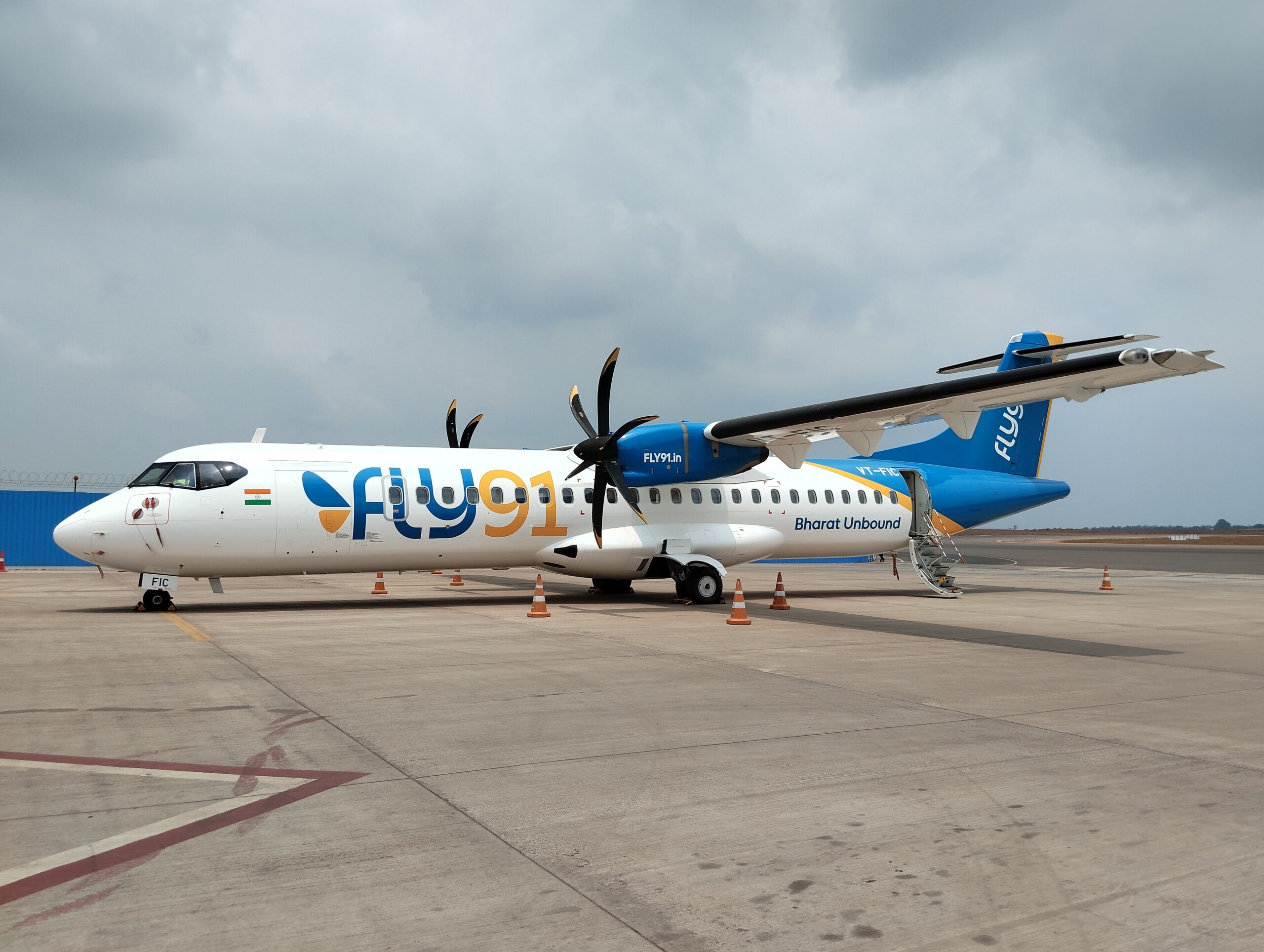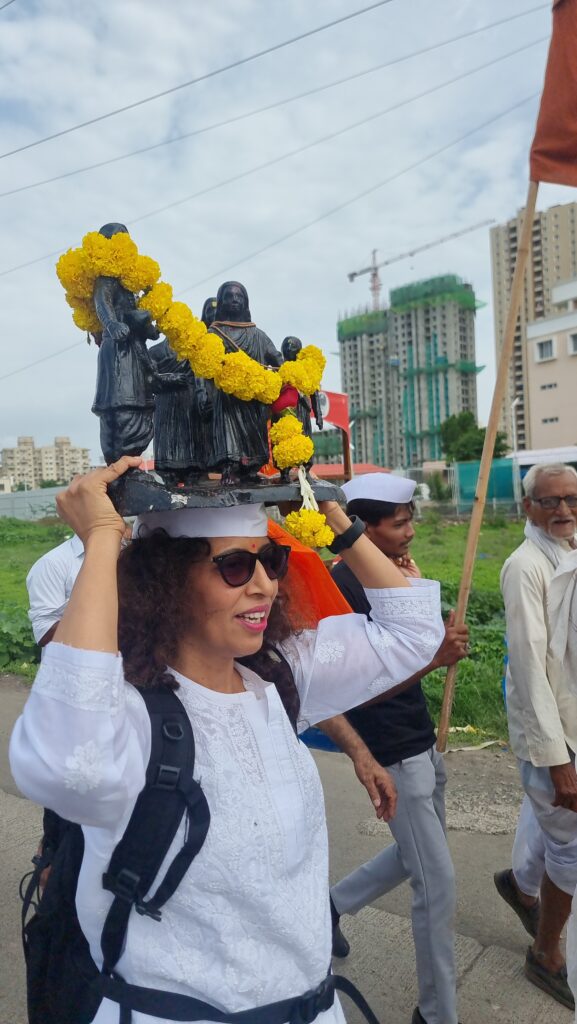
Sheetal Pai Kane, a fitness enthusiast, an entrepreneur and a well known figure from Goa, walked over 200 km in six days as part of her first Pandharpur wari, a culturally significant pilgrimage undertaken in worship to Lord Vitthal in Pandharpur, Maharashtra. On her return, Sheetal shares what moved her to undertake the pilgrimage, the divine toil and camaraderie along the wari and why more Goans should experience the spiritual journey.
Was this your first Wari?
Yes, this was my first time performing the wari. I’ve always been into fitness, trekking and hiking, but I had never participated in a spiritual walk like this before. It was my first pilgrimage of this kind.
Was it any different from the active lifestyle you live? Was it difficult or easy enough to complete the walk?
I absolutely loved it. The wari is an incomparable experience — emotionally, spiritually and physically. It’s a 21-day pilgrimage that begins from Dehu and Alandi with the padukas (sacred sandals) of Sant Dnyaneshwar and Sant Tukaram and ends in Pandharpur. This tradition has been alive for over 1,000 years and is open to everyone. There’s no fee or individual registration.
When you walk as part of a dindi (a group of pilgrims), the group registers and is given a token number. A dindi can be as small as eight- ten people or as large as a thousand. They often have support vehicles for cooking and rest. I had observed the wari practice growing up, especially around Ashadhi Ekadashi. And since Pandurang-Vitthal is the deity on my paternal side, I was always familiar with the culture. But this was my first time being a part of it.
Did you prepare in any way before going for the wari?
Not really. I had barely a week to put everything together. I was initially planning to drive to Pune, but my Rotary Club (Panjim Midtown) decided to fly in and I joined them. We flew with FLY91 from Goa to Pune; a super convenient and smooth experience. My preparation mostly involved calling friends who had participated in the wari earlier. They guided me on what to pack, how to plan stays and how the days typically go.
What drove you to embark on one?
Curiosity, honestly. I’d always seen people walking — whether in rain or intense sun — and wondered what drives them. Why do they walk? What do they gain? I didn’t want to keep asking. I wanted to feel it myself. I was also inspired by a close trekking friend who joined a warkari group from Goa last year and described it as a deeply moving experience. With Ashadhi Ekadashi approaching, I felt this year was the right time. Life has a way of aligning things and I didn’t want to postpone it.
What does Lord Vitthal signify in your life?
To me, Vitthal is a form of Krishna warm, approachable, deeply rooted in everyday life. What I love most is that the Pandharpur temple is open to all, regardless of caste or class. You’re allowed to go right up and touch the Lord’s feet. That kind of intimacy fosters a special bond. For me, he’s a very accessible, personal god.
How many days did the pilgrimage take?
The full wari from Alandi to Pandharpur spans 21 days and about 250 km. Since I didn’t have that much time, I began my walk from Hadapsar (Pune) and covered 210 km over six days. I compressed what would usually be done in three weeks into a much more intense schedule.
What is a typical day on a wari like?
The first day was incredibly special. I walked with our Rotary group, starting from Wadki Naka in Pune towards Saswad. That day alone had over 10 lakh people walking. It was breathtaking — an ocean of white-clad men in dhotis and Gandhi topis and women in green or red sarees. We joined a dindi and chanted along with them. Though we were dressed differently, they were so welcoming. They let me carry the auspicious tulsi on my head, shared stories and explained traditions like following the flag and the number placard each dindi carries. Eventually, my group returned home and I continued alone. From the second day onwards, I walked solo.
How many were part of your group? Could you identify some accompanying pilgrims and their backgrounds?
Initially, I walked with my Rotary group, but apart from them, I didn’t know anyone personally. From Day Two, I had to continue alone. Along the way, I met many other pilgrims who were also compressing the 21-day wari into fewer days.
One memorable encounter was with two couples from Pune who had done the wari seven times earlier. They were kind enough to share tips how to pace myself, where to take breaks, what to carry. For a first time pilgrim, their wisdom and kindness were incredibly comforting.
What are some key moments of joy or hardship you encountered along the way?
I wouldn’t call them hardships. The journey, in fact, was full of joy. But yes, there were physical challenges. Walking 35+ km a day gave me blisters and swelling, especially by Day Three and Four. I hadn’t carried bigger shoes, so my feet were really struggling. Walking from Saswad to Jejuri in the rain was tough, but manageable. The mornings were my favourite peaceful, cool and quiet. One moment I’ll never forget happened on Day Five. I was exhausted and stopped for tea. An elderly man offered me chai and biscuits. When I took off my shoes to apply ointment, his daughter came out and began pressing my feet.
I was shocked and tried to stop her, but she said helping a pilgrim brings punya. Strangers offered pitla-bhakri, let me rest in their homes, even let me use their washrooms. That generosity is something we’ve lost in urban life.
Could you share some lessons you learnt from the wari?
One of the most touching lessons was the warmth and generosity of rural Maharashtra. On a couple of occasions, I asked women sitting outside their homes if I could use their washroom not only did they say yes, they offered me water and even breakfast. It made me reflect on how guarded we’ve become in the cities. In urban areas, we’d hesitate if a stranger asked to use our washroom. But on the wari, people opened their homes without a second thought. Another powerful lesson was the self-discipline and order of the wari. Even with lakhs of people, there was no chaos. No pushing, no shouting. If one group paused, others waited. It felt like a self regulating ecosystem calm, respectful and guided by shared devotion.
One morning, I needed to rejoin the walk and a havaldar stopped our vehicle. I explained, but he gently said, “Mauli (Vittal’s followers are also referred to as mauli in reverence), I understand, but I can’t let you through. If you miss a few kilometres, walk that many rounds around the temple in Pandharpur Vitthal will understand.” That kindness and reverence even from police managing crowds left a deep impression.
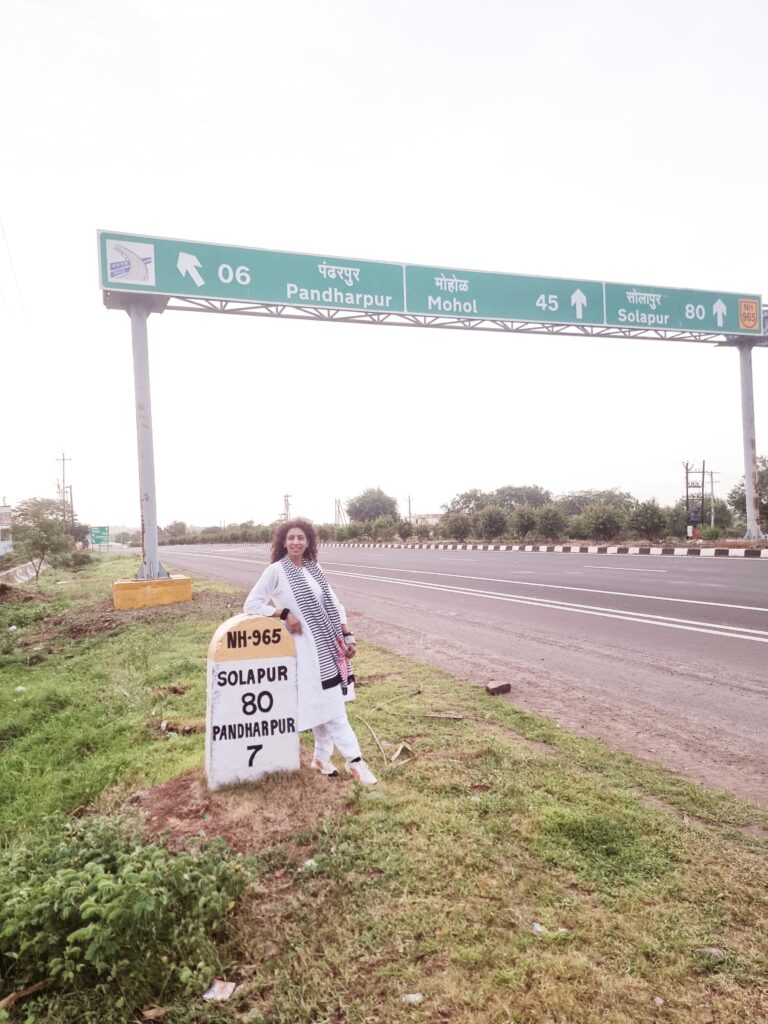
a highway milestone as she nears the end of her transformative padayatra on the
sacred wari route.
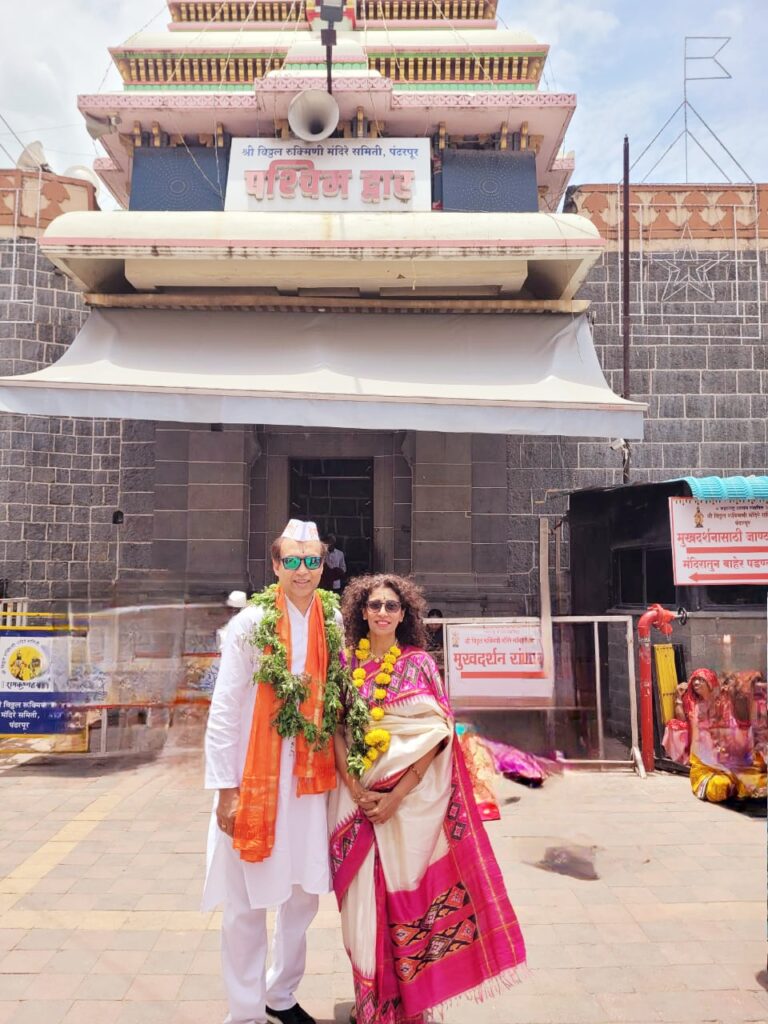
Mandir in Pandharpur, marking the culmination of their spiritual journey during the
Wari.
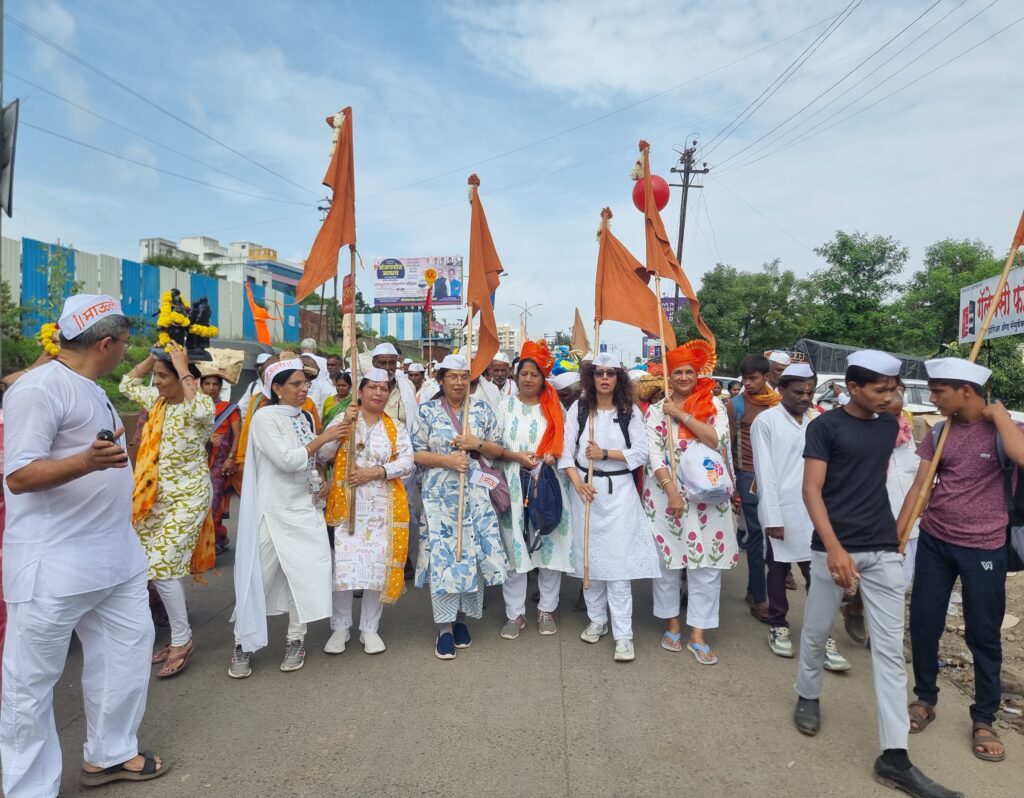
Padayatra as part of the Pandharpur Wari, proudly walking with the warkaris
under the saffron flags of faith.
Do you think direct connectivity to Solapur would help more Goans participate in the wari, knowing the return journey home would be taken care of by the direct Solapur–Goa connectivity facilitated by FLY91?
Oh yes, definitely. I can give you a real example. My husband, Sunil Pai Kane, had told me he would join me for the last leg of the walk in Pandharpur. He was only able to do that because of the direct flight from Goa to Solapur by FLY91. He took the 7.10 am flight and landed around 8.20 am. From Solapur, it took him about an hour by road to reach Pandharpur, so by 9.45 or 10 am, he was with me. We were able to walk the final stretch together, which was incredibly special. He was so impressed by how seamless it was that he even posted about it on social media. Earlier, the drive would take 7–8 hours one way, making it a two- day affair. Now, with FLY91’s flight, it becomes a same-day, stress-free journey. I’ve already decided this is the route I’ll take for every future visit to Pandharpur. It’s a fantastic initiative by FLY91, and I’m sure it will encourage many more Goans to take up the wari or simply visit Pandharpur without hesitation.
My Goa–Pune leg was my first FLY91 flight, though my children had flown on the regional airline before. The experience was seamless — smooth check in, well- timed flight and warm service. I even nodded off mid-flight and the crew let me rest undisturbed. I feel deeply grateful. The wari was personal and transformative, and what FLY91 is doing — connecting tier-2 and tier-3 cities to urban centres — is invaluable. It preserves the cultural essence of these places while making them more accessible to people like us, living in fast-paced cities. I hope more people experience this side of India.
BOX:
Comment from Sunil Pai Kane, Group CFO, Pai Kane Group
When I learned about the Goa – Solapur route being opened by FLY91, it was a truly exciting development — especially as the Wari had just commenced and all attention was focused on the movement towards Pandharpur. Enhanced connectivity to tier 3 cities is a remarkable step forward. The fact that one could leave home in Goa at 6 a.m. and reach Pandharpur by 10 am— in under four hours — was astounding. I still recall how, in the past, we had to break the journey with an overnight halt in Kolhapur, followed by a long drive of three to four hours to Pandharpur the next day. So, being able to travel from home to Pandharpur seamlessly and efficiently was truly a revelation.
Personally, I’ve flown with FLY91 quite regularly to Bengaluru, Pune, and other sectors, and I must say I’ve consistently had a wonderful experience. The service feels personalized, and I’ve seen fellow travelers receive the same warm attention, which speaks volumes about the airline’s consistency. This journey also marked my first time landing in an aircraft at a smaller, tier 3 city airport—and that, too, was a unique and memorable experience.”
Comment from Manoj Chacko, MD and CEO FLY91
“It’s commendable that Sheetal has completed the 210km Pandharpur Wari and we at FLY91 are happy to be part of her experience.” Commenting on the connectivity between Goa and Solapur he added, ” Among our destinations — Sindhudurg, Jalgaon, Solapur, Agatti (Lakshadweep), Goa, Hyderabad, Bengaluru and Pune — several also double up as key pilgrim hubs. Solapur, for instance, is extremely popular due to its proximity to Pandharpur, home to the revered Vitthal-Rukmini temple, which draws lakhs of devotees, especially during the Ashadhi Ekadashi period. With FLY91’s direct flights connecting Goa and Solapur, travellers and pilgrims can now conveniently access religious and cultural heritage destinations such as Pandharpur (Vitthal- Rukmini Temple), Tuljapur (Tulja Bhavani Temple), Akkalkot (Swami Samarth Maharaj Temple), Gangapur (Sri Narasimha Saraswati Swami Math) and the Bhimashankar Jyotirlinga, important spiritual hubs attracting millions of visitors annually from Maharashtra and other parts of the country. FLY91 is the only airline which beautifully connects these devotional destinations to Goa.”

